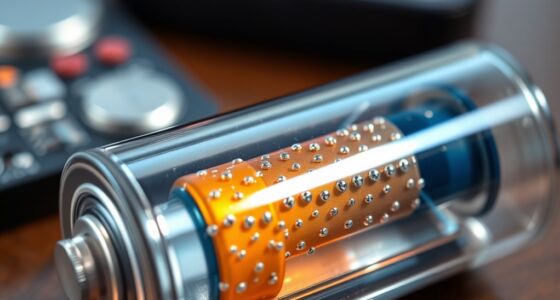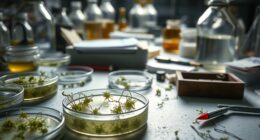Chemical reactions are the invisible forces behind many parts of your daily life. They power the energy you use for heating, transportation, and cooking. They also help preserve your food, create the textures and flavors you enjoy, and improve personal care products. Modern technology relies on chemical reactions for electronics and environmental solutions. Understanding these processes reveals how chemistry shapes your world, and if you keep exploring, you’ll uncover even more fascinating examples in everyday life.
Key Takeaways
- Chemical reactions generate energy for heating, transportation, and industrial processes like electricity production.
- They cause material changes such as rusting, tarnishing, and electroplating, affecting everyday objects and durability.
- Reactions like baking, caramelization, and Maillard develop flavors, colors, and textures in food preparation.
- Body processes like respiration convert nutrients into ATP, powering vital functions and physical activity.
- Food preservation, personal care, and technology rely on chemical reactions for safety, effectiveness, and innovation.
The Role of Combustion in Daily Life
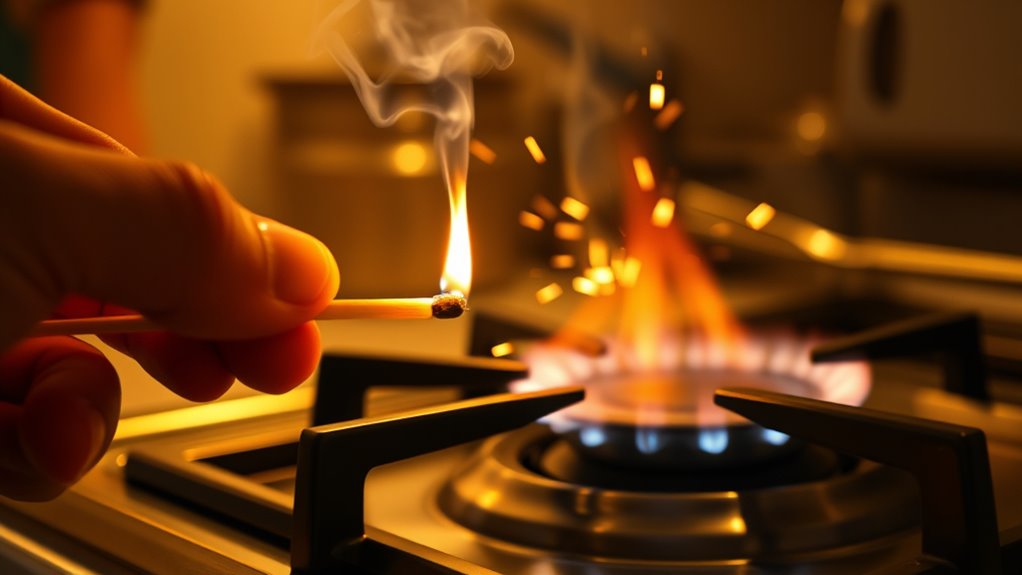
Have you ever wondered how combustion touches your daily life? It’s all around you, providing the energy needed for heating, cooking, and transportation. When you light a stove or a fireplace, combustion releases heat and light, making your home cozy. Your car runs on internal combustion engines that convert fuel into motion, powering your daily commute. Even the food you cook relies on burning natural gas or propane. In industry, combustion fuels power plants and manufacturing processes, creating everything from electricity to building materials. Fireworks light up celebrations through rapid combustion, while candles and grills use burning fuels for ambiance and food. Without combustion, many everyday activities and conveniences would come to a halt. Additionally, advancements in sustainable fuel sources are helping to reduce environmental impacts associated with combustion processes.
How Our Bodies Use Chemical Reactions for Energy

Your body relies on complex chemical reactions to generate the energy needed for daily activities. It stores energy in organic molecules like sugars and fats, which are broken down through controlled oxidation, primarily glucose. This process produces energy that’s converted into ATP, the cellular “currency” used for work. Each glucose molecule can generate about 30 to 32 ATP molecules, providing ample energy for muscles, nerve function, and other activities. Your body switches between aerobic respiration, which requires oxygen and yields more ATP, and anaerobic respiration when oxygen is scarce, producing less energy. Mitochondria are the powerhouses where most ATP synthesis occurs. These reactions are essential for maintaining your metabolic rate and supporting everything from simple movements to complex bodily functions.
The Science Behind Baking and Cooking

Baking and cooking involve a series of chemical reactions that transform raw ingredients into flavorful, appealing dishes. The Maillard reaction occurs when heat activates proteins and reducing sugars above 140°C, creating browning and complex flavors, like the crust on bread or grilled meats. Caramelization happens when sugars decompose at temperatures above 160°C, producing a golden color and sweet, nutty taste. Leavening agents, such as baking soda and yeast, generate carbon dioxide gas that makes dough rise and creates airy textures. Gluten forms when flour mixes with water, developing an elastic network that traps gas and provides structure. Heat also causes proteins to coagulate and starches to gelatinize, setting the shape and texture of baked goods. These chemical processes work together to turn simple ingredients into delicious, satisfying foods. Additionally, understanding the chemical composition of ingredients can help optimize flavor and texture outcomes in various recipes.
Chemical Processes in Food Preservation
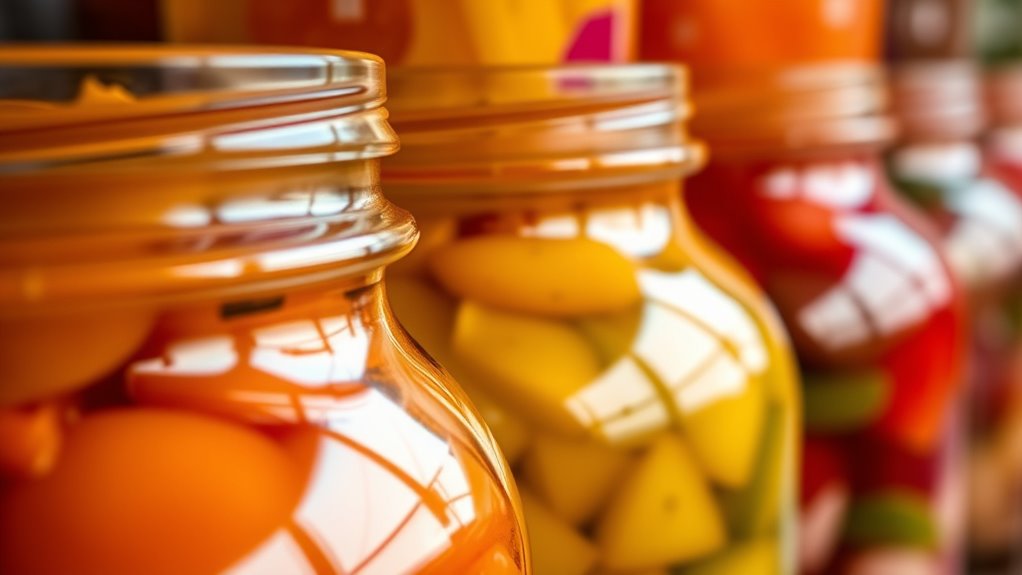
Food preservation relies on chemical processes that inhibit spoilage and extend shelf life. You use methods like canning, freezing, drying, irradiation, and salting, which all involve chemical reactions that slow down or stop bacterial and enzyme activity. Chemical preservatives such as benzoates, nitrates, sulphites, antioxidants, and pH adjusters target microbial growth and oxidation. These chemicals work by controlling pH, inactivating enzymes, or preventing lipid oxidation, ensuring food remains safe and fresh longer. Often, multiple techniques combine to maximize preservation. While chemical preservatives boost food safety and shelf life, concerns about health and environmental impacts exist. Advances like natural preservatives and innovative technologies aim to maintain food quality while minimizing risks, making food preservation both effective and safer for consumers. Additionally, understanding the chemical reactions involved helps in developing more effective and safer preservation methods.
Everyday Materials and Their Transformations

Everyday materials often undergo chemical transformations that change their properties and appearance. For example, iron rusts when it reacts with oxygen and moisture, forming flaky, reddish-brown rust that weakens the metal. Copper develops a greenish patina called verdigris after exposure to air, altering its surface. Silver tarnishes due to a reaction with sulfur compounds, creating a black layer of silver sulfide. Baking soda reacts with acids like vinegar, producing carbon dioxide gas that helps in cooking and cleaning. Electroplating uses chemical reactions to coat objects with a metal layer, improving durability and look. These transformations show how common materials change chemically, affecting their function and aesthetics in your daily life, often requiring cleaning or treatment to restore their original properties. Recognizing signs of chemical change can help in understanding how everyday reactions influence material durability and maintenance.
Chemical Reactions That Protect Our Environment

Have you ever wondered how chemical reactions can help protect our environment? Catalytic reactions play a key role by replacing large amounts of reagents, reducing waste and energy use. Small quantities of catalysts can be reused multiple times, cutting down material waste and lowering emissions through more efficient processes. These reactions are widely used in pharmaceuticals and fuel production, supporting a circular economy by making resource use more sustainable. Chemically designed degradable products also help; biodegradable plastics and compostable items break down into harmless substances, preventing pollution and microplastics. Additionally, real-time monitoring systems detect hazardous byproducts during manufacturing, enabling immediate adjustments to minimize pollution. Safer synthesis methods using non-toxic solvents and energy-efficient techniques further reduce risks, making chemical reactions essential tools in protecting our environment. Incorporating environmentally friendly plant-based materials in chemical processes further enhances sustainability efforts.
Fun Home Experiments Demonstrating Chemistry
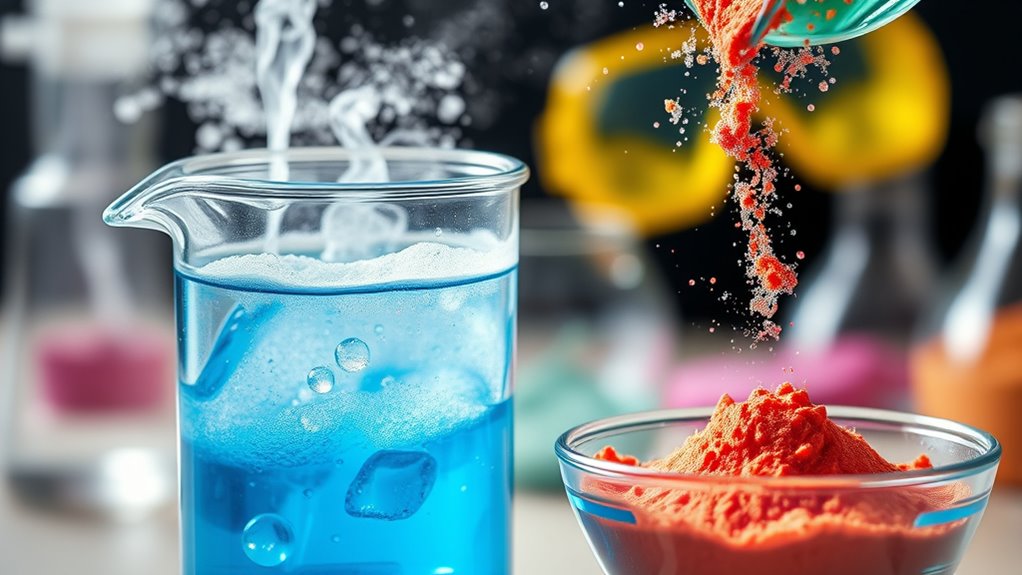
Chemistry isn’t just for scientists in labs; it’s also perfect for fun at home. You can explore chemical reactions with simple, safe experiments. For example, mixing baking soda and vinegar creates bubbles of carbon dioxide, showing an acid-base reaction. Making slime with glue and borax demonstrates polymerization, which gives the slime its stretchy texture. The Mentos and soda trick explodes with gas, revealing nucleation in action. Using vinegar and salt to clean pennies shows a chemical reaction that removes tarnish. You can even write invisible messages with lemon juice that appear when heated, revealing oxidation. These experiments are easy to do, safe, and provide a hands-on way to see chemistry in everyday life while having fun. Additionally, understanding chemical reactions can help you grasp how everyday products and processes work, making chemistry more relevant and engaging.
The Chemistry of Beauty and Personal Care Products
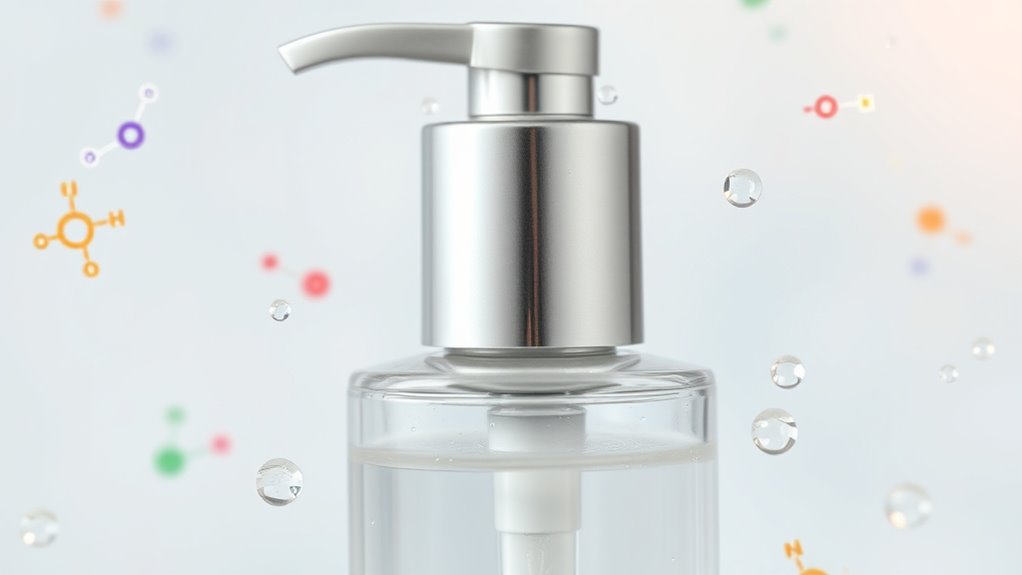
Did you know that the beauty and personal care products you use daily rely on complex chemical formulas to work effectively? These products contain a mix of water, emulsifiers, preservatives, thickeners, and active ingredients designed to improve your appearance and skin health. Emollients like glycerin and petroleum jelly soften skin and hair by forming protective layers, while preservatives such as parabens prevent microbial growth and extend shelf life. Active ingredients like citric acid brighten skin, and sunscreens like zinc oxide block harmful UV rays. Surfactants, including sodium lauryl sulfate, help cleanse by emulsifying oils and dirt. Formulating these products involves balancing ingredients to guarantee safety, stability, and effectiveness, with advances in nanotechnology enhancing delivery and targeted action. All these chemicals work together to keep your personal care routine effective and safe. Additionally, understanding the chemical composition of these products can help you make more informed choices about what you apply to your skin.
How Chemical Reactions Power Modern Technology
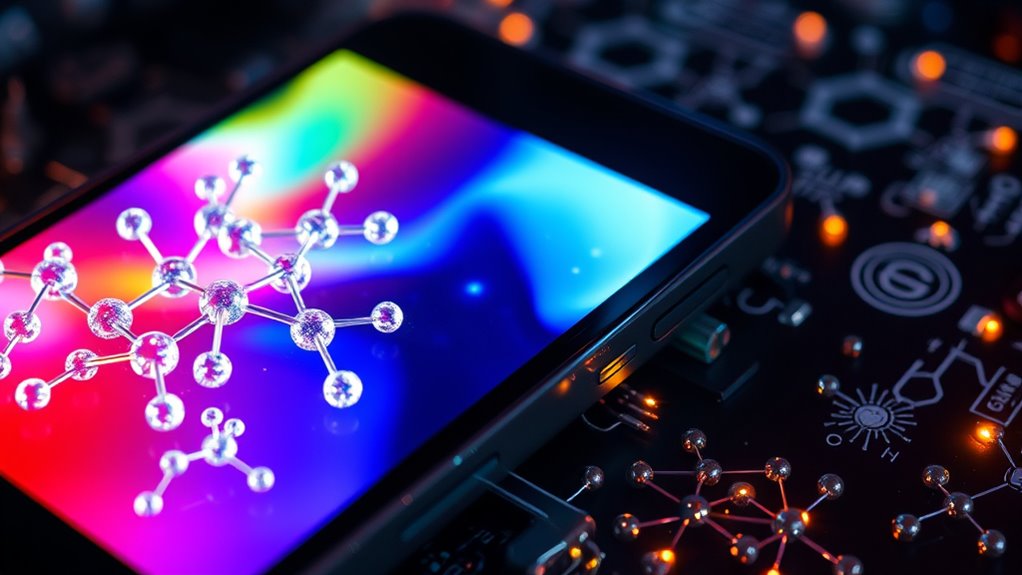
Ever wondered how chemical reactions drive the technology we rely on daily? They’re behind the development of advanced materials in computing and telecommunications, like semiconductors and fiber optic cables. These reactions enable faster data processing and more efficient devices, making your tech work quicker and last longer. Chemical coatings protect electronics, improving durability, while innovations in materials boost energy efficiency. In smart appliances, chemical reactions power energy-saving features, help develop better sensors, and create durable plastics. They also improve heating, cooling, and water purification systems. In pharmaceuticals, reactions synthesize active ingredients and develop new drugs. Chemical processes are essential for environmental tech too, purifying water, reducing pollutants, and recycling waste. Additionally, many of these reactions are carefully controlled using specialized equipment to ensure safety and precision. Without these reactions, modern technology wouldn’t be as advanced, efficient, or sustainable as it is today.
Frequently Asked Questions
How Do Chemical Reactions Affect the Durability of Everyday Products?
Did you know that oxidation, like rusting, weakens metals by up to 25% over time? Chemical reactions directly impact product durability; for example, exposure to moisture and UV rays accelerates degradation. You can prevent this by using protective coatings or choosing materials designed to resist these reactions. By understanding these processes, you make smarter choices, ensuring your everyday items last longer and perform better in changing environmental conditions.
Can Chemical Reactions in Nature Be Influenced by Human Activity?
Yes, human activity can influence chemical reactions in nature. When you burn fossil fuels, pollutants like nitrogen oxides and sulfur dioxide react with water vapor, creating acid rain that harms ecosystems. Your use of chemicals and land management also alters natural cycles, affecting soil and water chemistry. By understanding these impacts, you can help reduce pollution and support more sustainable practices that minimize disruption to natural chemical reactions.
What Safety Precautions Are Essential During Household Chemical Experiments?
Did you know that improper handling of household chemicals causes over 30,000 poisoning incidents annually? During experiments, you must wear PPE like gloves, goggles, and closed-toed shoes to protect yourself. Always store chemicals safely, keep them away from heat, and read labels carefully. Conduct experiments in ventilated areas, have emergency supplies ready, and avoid mixing chemicals unless you’re sure of the reaction. Safety isn’t just a rule—it’s a lifesaver.
How Do Chemical Reactions Contribute to Renewable Energy Sources?
Chemical reactions play a essential role in renewable energy sources by converting natural resources into usable fuel and electricity. You leverage electrolysis to split water into hydrogen, a clean energy carrier, and harness catalysts to improve reaction efficiency. Solar energy is transformed into electricity through photoexcitation, while biomass processes produce hydrogen from plant waste. These reactions help reduce reliance on fossil fuels, making sustainable energy more achievable for your daily life.
Are There Environmental Impacts From Common Chemical Reactions in Daily Life?
You might not realize it, but many daily chemical reactions impact the environment. When you use household cleaners, cook food, or drive, chemical processes release pollutants like VOCs, greenhouse gases, and toxins into air, water, and soil. These pollutants can harm your health, damage ecosystems, and contribute to climate change. By choosing eco-friendly products and proper disposal, you can reduce these environmental impacts and promote a healthier planet.
Conclusion
Every day, chemistry surrounds you. It powers your mornings and fuels your afternoons. It transforms your food and preserves your favorites. It protects your environment and enhances your beauty. It drives your technology and energizes your body. Embrace the wonder of these reactions happening all around you. Recognize the chemistry in your life. Celebrate the science that makes everything possible. Because in every moment, chemistry is shaping your world.



